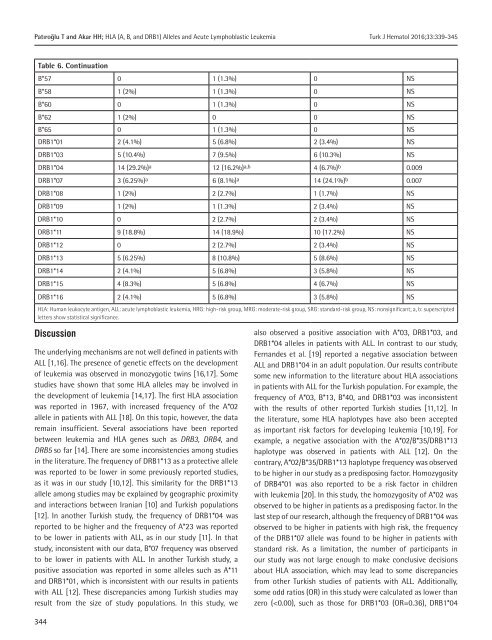Turkish Journal of Hematology Volume: 33 - Issue: 4
Create successful ePaper yourself
Turn your PDF publications into a flip-book with our unique Google optimized e-Paper software.
Patıroğlu T and Akar HH; HLA (A, B, and DRB1) Alleles and Acute Lymphoblastic Leukemia<br />
Turk J Hematol 2016;<strong>33</strong>:<strong>33</strong>9-345<br />
Table 6. Continuation<br />
B*57 0 1 (1.3%) 0 NS<br />
B*58 1 (2%) 1 (1.3%) 0 NS<br />
B*60 0 1 (1.3%) 0 NS<br />
B*62 1 (2%) 0 0 NS<br />
B*65 0 1 (1.3%) 0 NS<br />
DRB1*01 2 (4.1%) 5 (6.8%) 2 (3.4%) NS<br />
DRB1*03 5 (10.4%) 7 (9.5%) 6 (10.3%) NS<br />
DRB1*04 14 (29.2%) a 12 (16.2%) a,b 4 (6.7%) b 0.009<br />
DRB1*07 3 (6.25%) a 6 (8.1%) a 14 (24.1%) b 0.007<br />
DRB1*08 1 (2%) 2 (2.7%) 1 (1.7%) NS<br />
DRB1*09 1 (2%) 1 (1.3%) 2 (3.4%) NS<br />
DRB1*10 0 2 (2.7%) 2 (3.4%) NS<br />
DRB1*11 9 (18.8%) 14 (18.9%) 10 (17.2%) NS<br />
DRB1*12 0 2 (2.7%) 2 (3.4%) NS<br />
DRB1*13 5 (6.25%) 8 (10.8%) 5 (8.6%) NS<br />
DRB1*14 2 (4.1%) 5 (6.8%) 3 (5.8%) NS<br />
DRB1*15 4 (8.3%) 5 (6.8%) 4 (6.7%) NS<br />
DRB1*16 2 (4.1%) 5 (6.8%) 3 (5.8%) NS<br />
HLA: Human leukocyte antigen, ALL: acute lymphoblastic leukemia, HRG: high-risk group, MRG: moderate-risk group, SRG: standard-risk group, NS: nonsignificant; a, b: superscripted<br />
letters show statistical significance.<br />
Discussion<br />
The underlying mechanisms are not well defined in patients with<br />
ALL [1,16]. The presence <strong>of</strong> genetic effects on the development<br />
<strong>of</strong> leukemia was observed in monozygotic twins [16,17]. Some<br />
studies have shown that some HLA alleles may be involved in<br />
the development <strong>of</strong> leukemia [14,17]. The first HLA association<br />
was reported in 1967, with increased frequency <strong>of</strong> the A*02<br />
allele in patients with ALL [18]. On this topic, however, the data<br />
remain insufficient. Several associations have been reported<br />
between leukemia and HLA genes such as DRB3, DRB4, and<br />
DRB5 so far [14]. There are some inconsistencies among studies<br />
in the literature. The frequency <strong>of</strong> DRB1*13 as a protective allele<br />
was reported to be lower in some previously reported studies,<br />
as it was in our study [10,12]. This similarity for the DRB1*13<br />
allele among studies may be explained by geographic proximity<br />
and interactions between Iranian [10] and <strong>Turkish</strong> populations<br />
[12]. In another <strong>Turkish</strong> study, the frequency <strong>of</strong> DRB1*04 was<br />
reported to be higher and the frequency <strong>of</strong> A*23 was reported<br />
to be lower in patients with ALL, as in our study [11]. In that<br />
study, inconsistent with our data, B*07 frequency was observed<br />
to be lower in patients with ALL. In another <strong>Turkish</strong> study, a<br />
positive association was reported in some alleles such as A*11<br />
and DRB1*01, which is inconsistent with our results in patients<br />
with ALL [12]. These discrepancies among <strong>Turkish</strong> studies may<br />
result from the size <strong>of</strong> study populations. In this study, we<br />
also observed a positive association with A*03, DRB1*03, and<br />
DRB1*04 alleles in patients with ALL. In contrast to our study,<br />
Fernandes et al. [19] reported a negative association between<br />
ALL and DRB1*04 in an adult population. Our results contribute<br />
some new information to the literature about HLA associations<br />
in patients with ALL for the <strong>Turkish</strong> population. For example, the<br />
frequency <strong>of</strong> A*03, B*13, B*40, and DRB1*03 was inconsistent<br />
with the results <strong>of</strong> other reported <strong>Turkish</strong> studies [11,12]. In<br />
the literature, some HLA haplotypes have also been accepted<br />
as important risk factors for developing leukemia [10,19]. For<br />
example, a negative association with the A*02/B*35/DRB1*13<br />
haplotype was observed in patients with ALL [12]. On the<br />
contrary, A*02/B*35/DRB1*13 haplotype frequency was observed<br />
to be higher in our study as a predisposing factor. Homozygosity<br />
<strong>of</strong> DRB4*01 was also reported to be a risk factor in children<br />
with leukemia [20]. In this study, the homozygosity <strong>of</strong> A*02 was<br />
observed to be higher in patients as a predisposing factor. In the<br />
last step <strong>of</strong> our research, although the frequency <strong>of</strong> DRB1*04 was<br />
observed to be higher in patients with high risk, the frequency<br />
<strong>of</strong> the DRB1*07 allele was found to be higher in patients with<br />
standard risk. As a limitation, the number <strong>of</strong> participants in<br />
our study was not large enough to make conclusive decisions<br />
about HLA association, which may lead to some discrepancies<br />
from other <strong>Turkish</strong> studies <strong>of</strong> patients with ALL. Additionally,<br />
some odd ratios (OR) in this study were calculated as lower than<br />
zero (

















